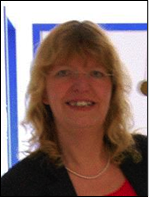Date
Cost
Free and open to the public
Location
Research Pavilion, Room 169 (NanoScience Technology Center)
Description
Abstract: Due to the continuous miniaturization of electronic and optical devices, the importance of functionalized nanoparticles (NPs) has drastically increased in the past few years. In contradiction to the analogous bulk samples, lanthanide doped luminescent NPs present several advantages as high packing density, low light scattering effects, energy saving synthesis (with shorter preparation time and lower sintering temperatures) and are easily suspendable in liquid media. Due to the small size, nanophosphors are able to build thinner films simply by printing e.g. on the surface of light emitting diodes (LEDs) and are less subjected to concentration quenching effects, in comparison to doped micron-sized phosphors. Moreover, core-shell NPs can be functionalized on their surface and are therefore suitable as biological sensors or medical markers. In this presentation, we present several different lanthanide doped NPs and their optical properties. Above all, Eu2+ containing NPs are very interesting in this context, which are most important for all respective applications. However, the common preparation methods using water as solvent in general do not work due to the oxidation behavior of Eu2+ ions. Therefore, we developed novel synthesis methods, e.g. in ionic liquids as solvent. By the usage of fluoride containing ionic liquids it is also possible to prepare fluoridic NPs which are not available by common melting methods. In detail, we were successful preparing phase pure samples of several flouridic Eu2+ doped materials with small sizes and low size distributions (30-40 nm) with extremely high luminescence quantum yields for the first time. Finally, some applications in biological and medical fields (e.g. medical sensors) and also multifunctional magnetic, afterglow NPs are presented, showing their large benefits compared to common materials due to their higher stability at extremely low toxicity. Especially afterglow nanoparticles overcome the problem of absorption of visible radiation of biological tissue because it can be exited before injection.
Biography:
Claudia Wickleder earned a PhD in Physical Chemistry, Laser Spectroscopy on Molecular Beams studying with Prof. Dr. Hanns von Weyssenhoff at Hannover University in Germany. After a Postdoctoral stay in Physical Chemistry, Laser Spectroscopic Investigations of Bond Energies with Prof. Dr. Samuel Leutwyler at University of Bern in Switzerland, she did her Habilitation in Inorganic Chemistry, Synthesis and optical Characterization of divalent Lanthanides containing Halides at the University at Cologne in Germany. Since November 2004 Dr. Wickleder has been Chair of Inorganic Material Chemistry and Faculty for Science and Technology at University of Siegen in Germany. Dr. Wickleder’s research interests are functional materials for optical applications: materials for illumination purposes, photovoltaic materials, materials for security applications and sensoring; structural materials: luminescent nanoparticles, thin films and MOFs, oxidic nanoparticles for several application (e.g. photocatalysis, antibacterial surfaces); luminescent properties of trivalent and divalent rare earth, luminescence of lanthanide free materials for saving resources, luminescence of semiconductors; and solid state and coordination chemistry: synthesis and structure determination of new compounds.
Presenter

Dr. Claudia Wickleder
Chair of Inorganic Material Chemistry, Faculty for Science and Technology
University of Siegen
Germany
More information
Light refreshments will be served
Contact
Swadesh Santra, Ph.D. NanoScience Technology Center Swadeshmukul.Santra@ucf.edu